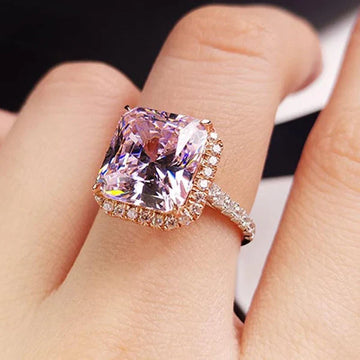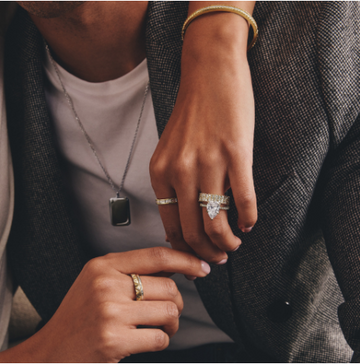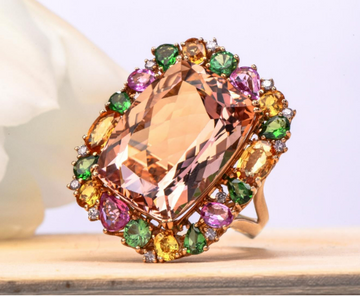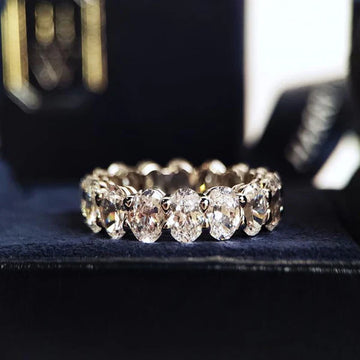The ring pictured showcases a breathtaking blend of modern design and delicate femininity. The centerpiece is a large, radiant-cut, pink gemstone, likely a diamond (natural or lab-grown) or a high-quality cubic zirconia. This captivating stone, set within a halo of smaller diamonds and framed by a rose gold setting, exudes an air of sophisticated luxury. But beyond its stunning appearance lies a wealth of fascinating science, history, and market dynamics. Let’s dive in!
I. The Science of Color: How Pink Diamonds Get Their Hue
The most intriguing aspect of this ring is the captivating pink hue of the central gemstone. While the presence of trace elements like nitrogen causes yellow diamonds and boron leads to blue diamonds, the origin of pink diamonds’ color is a different story. It is believed to be a result of plastic deformation within the crystal lattice during its formation deep within the earth.
- Plastic Deformation: This refers to permanent changes in the shape of the diamond crystal due to immense pressure and stress. These stresses cause gliding and slipping of atomic planes within the diamond structure, creating defects known as “grain boundaries”.
- Color Centers: These grain boundaries selectively absorb light in the green region of the spectrum, allowing the red and pink wavelengths to be transmitted, giving the diamond its characteristic pink color. It is not a chemical impurity that is the sole cause of the color.
- Grading and Rarity: The Gemological Institute of America (GIA) grades pink diamonds on a scale ranging from Faint Pink to Fancy Deep Pink. The more intense the color, the rarer and more valuable the diamond.
II. A Journey Through History and the Symbolism of Pink
While diamonds themselves have been prized for centuries, pink diamonds hold a unique place in the world of gemstones:
- Argyle Mine: The Argyle mine in Western Australia, which ceased operations in 2020, was the world’s primary source of pink diamonds. Its closure has significantly impacted the supply and value of these already rare gems.
- Symbolism of Pink: Throughout history, the color pink has been associated with femininity, romance, tenderness, and compassion. In modern times, it has also become associated with awareness, as seen with the pink ribbon for breast cancer awareness.
- Record-Breaking Sales: Pink diamonds have consistently fetched astronomical prices at auction, demonstrating their desirability and investment potential. The “Pink Star” diamond, a 59.60-carat Fancy Vivid Pink diamond, sold for over $71 million in 2017, setting a world record for the most expensive gemstone ever sold at auction.
III. Dissecting the Ring’s Design
This ring elegantly combines classic and contemporary elements:
- The Radiant Cut: The choice of a radiant cut for the center gemstone maximizes its brilliance and fire. This cut features a combination of step-cut and brilliant-cut facets, designed to enhance the diamond’s sparkle.
- Halo Setting: The halo of smaller diamonds surrounding the center stone not only adds to the overall sparkle but also makes the center stone appear larger. The halo also serves as a protective element for the main stone.
- Rose Gold Accent: The use of rose gold for the halo and prongs adds a touch of warmth and complements the pink diamond beautifully. Rose gold’s warm tone beautifully enhances the pink hues, creating a luxurious and romantic aesthetic.
- Pavé Band: The band is likely set with pavé diamonds, which are small diamonds set closely together to create a continuous sparkle. This adds to the overall elegance and glamour of the ring. The metal used for the band, which is not rose gold, can be anything from white gold, silver, or platinum.
IV. Understanding the Market for Pink Diamonds
- Rarity and Value: Natural pink diamonds are incredibly rare, making them highly sought after by collectors and investors.
- Lab-Grown Alternatives: Lab-grown pink diamonds offer a more accessible and ethical alternative for those who desire the look and beauty of a pink diamond without the hefty price tag or concerns about ethical sourcing. They share the same chemical and physical properties as natural diamonds but are created in a controlled laboratory environment.
- Cubic Zirconia Options: Cubic zirconia, while not as hard or brilliant as diamond, provides a budget-friendly option for those seeking a similar aesthetic. High-quality cubic zirconia can be cut and polished to resemble a diamond closely.
V. Styling and Occasion:
This ring is a statement piece that demands attention.
- Occasion: Perfect for formal events, anniversaries, or engagement rings for those who appreciate a unique and romantic touch.
- Style: Best worn with elegant outfits that complement the ring’s sophistication. Think classic evening gowns, cocktail dresses, or tailored suits.
- Other Jewelry: Keep other jewelry to a minimum, allowing the ring to be the focal point. Simple diamond studs or a delicate bracelet would be sufficient.
This ring is more than just an accessory; it is a symbol of rare beauty, refined elegance, and enduring value. Whether it features a natural pink diamond, a lab-grown equivalent, or a stunning cubic zirconia, this piece represents a unique blend of science, history, and timeless style.







